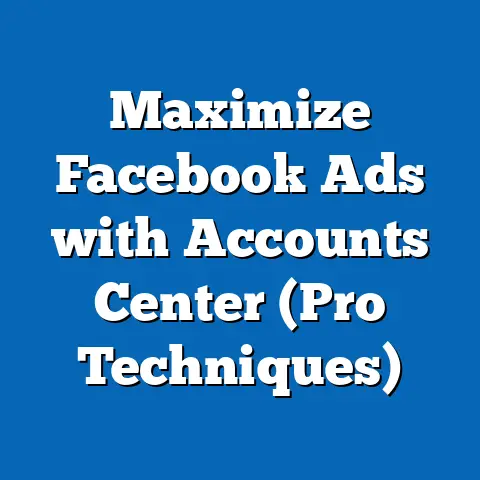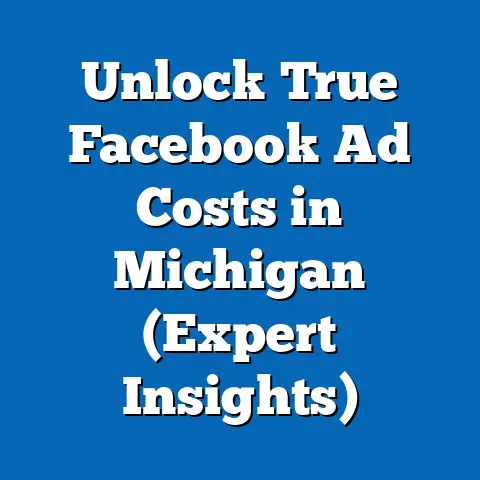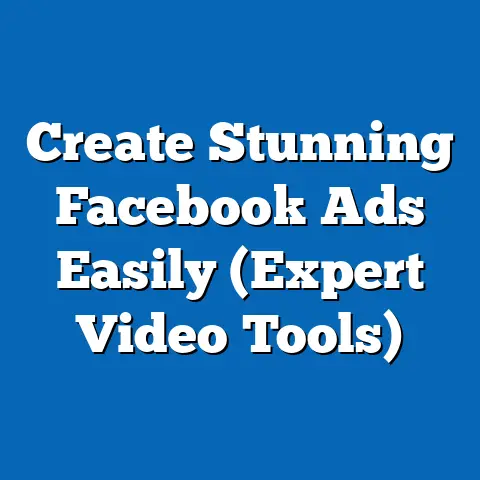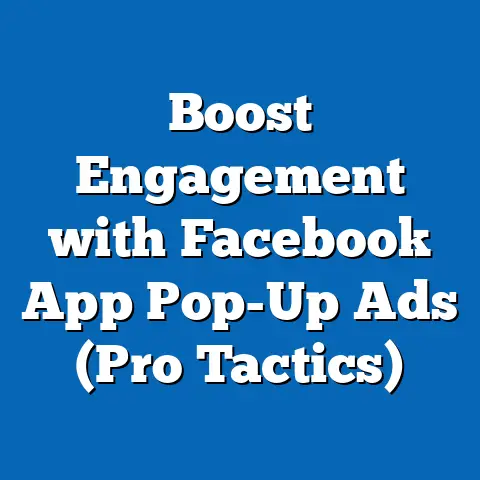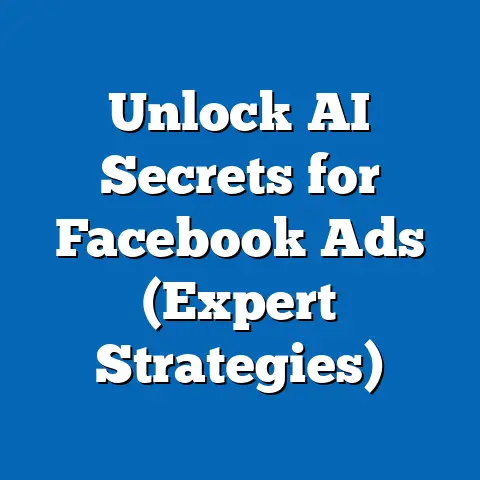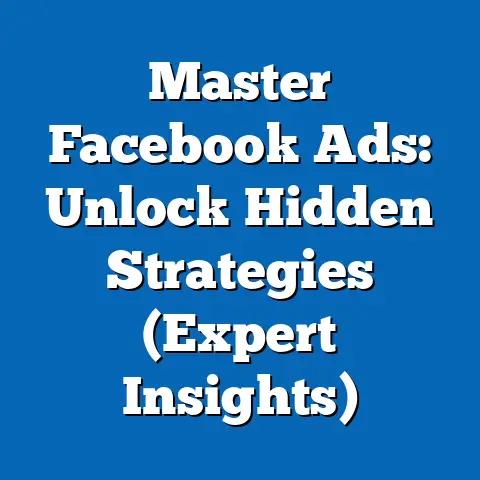Canceling Boosted Facebook Ad (Essential Guide)
In the ever-evolving world of Facebook advertising, there are a few “best-kept secrets” that can make or break your marketing strategy. While many marketers eagerly jump on the bandwagon of boosting posts for that instant visibility, a surprising number remain in the dark about the implications and the potential necessity of canceling these ads. I’ve been there myself, caught up in the initial excitement of seeing those engagement numbers climb, only to realize later that I wasn’t getting the ROI I needed.
This guide is designed to pull back the curtain and reveal the essential steps and insider tips for canceling boosted Facebook ads effectively. My goal is to empower you to manage your advertising budget with precision, ensuring every dollar spent contributes to your brand’s success, not wasted on underperforming campaigns. Think of this knowledge as your secret weapon, allowing you to take full control of your advertising strategy and avoid unnecessary spending. Let’s dive in and unlock the power of informed decision-making in the realm of Facebook advertising!
Understanding Boosted Posts
First, let’s clarify what we mean by “boosted posts.” A boosted post is essentially a regular Facebook post that you pay to show to a wider audience than your organic reach. It’s a simplified form of Facebook advertising, allowing you to quickly expand the visibility of a specific post to a targeted demographic.
How Boosted Posts Differ from Traditional Facebook Ads:
The key difference lies in the level of control and customization. Traditional Facebook ads, created through Ads Manager, offer a far more granular approach to targeting, ad formats, bidding strategies, and overall campaign management. Boosted posts, on the other hand, are designed for simplicity and speed. They offer limited targeting options and are primarily focused on increasing engagement on a single post.
The Purpose of Boosting Posts:
Businesses typically boost posts to achieve a variety of goals, including:
- Increased Engagement: This includes likes, comments, shares, and other forms of interaction with the post.
- Website Clicks: Driving traffic to a specific landing page on your website.
- Brand Awareness: Expanding the reach of your content to new audiences and increasing brand visibility.
- Local Awareness: Reaching people in a specific geographic area.
The Allure of Immediate Engagement:
I’ve seen countless businesses, especially those new to Facebook advertising, drawn to the immediate gratification of boosted posts. The promise of instant engagement and a wider audience is undeniably appealing. However, it’s crucial to understand that this immediate gratification doesn’t always translate into tangible business results.
Takeaway: Boosted posts are a quick and easy way to expand the reach of your content, but they offer limited control and may not always be the most effective advertising option.
Reasons for Cancelling Boosted Ads
While boosting posts can be a useful tool, there are several compelling reasons why you might need to pull the plug and cancel an ad. Recognizing these signs early is crucial to minimizing wasted ad spend and optimizing your overall marketing efforts.
1. Underperformance of the Ad:
This is perhaps the most common reason for canceling a boosted ad. If your engagement metrics (likes, comments, shares, click-through rates) are significantly lower than expected, it’s a clear indication that the ad isn’t resonating with your target audience. I’ve learned the hard way that sometimes, even the most compelling content can fall flat if it’s not reaching the right people or if the ad creative isn’t optimized for engagement.
2. Changes in Marketing Strategy or Budget Constraints:
Marketing strategies are rarely set in stone. As your business evolves, your goals and priorities may shift. Similarly, budget constraints can arise unexpectedly. In such cases, it might be necessary to reallocate your advertising budget and cancel underperforming boosted ads to free up resources for more promising initiatives. I remember one instance where a sudden shift in my client’s target demographic forced me to cancel several boosted ads and completely revamp our targeting strategy.
3. Negative Feedback or Comments on the Post:
This is a red flag that should never be ignored. If your boosted post is attracting negative feedback or generating controversy, it’s essential to take immediate action to protect your brand’s reputation. Canceling the ad is often the first step in mitigating the damage and preventing further negative publicity. I’ve seen brands suffer significant reputational damage due to ignoring negative comments on their boosted posts, so it’s always better to be proactive.
4. Seasonal Trends Affecting Ad Relevance:
The relevance of your ad content can fluctuate depending on seasonal trends, holidays, or current events. What might be a highly engaging post in one season could become completely irrelevant in another. I’ve learned to closely monitor seasonal trends and adjust my advertising campaigns accordingly, canceling boosted ads that are no longer timely or relevant.
5. Reaching Saturation:
Sometimes, an ad might perform well initially, but its effectiveness can diminish over time as it reaches a larger percentage of your target audience. This is particularly true for smaller, highly targeted audiences. If you notice a significant drop in engagement or click-through rates, it might be time to cancel the ad and explore fresh creative or targeting options.
Takeaway: Proactively monitoring your boosted ad performance and being prepared to cancel ads that are underperforming, generating negative feedback, or becoming irrelevant is crucial for maximizing your advertising ROI. Don’t be afraid to cut your losses and reallocate your budget to more promising campaigns.
How to Cancel a Boosted Facebook Ad
Now for the practical part: how exactly do you cancel a boosted Facebook ad? The process is relatively straightforward, but it’s important to follow the steps carefully to ensure the ad is completely stopped and you’re no longer being charged.
Step 1: Accessing the Ads Manager or the Specific Post:
There are two primary ways to access the boosted ad you want to cancel:
- Through Ads Manager: This is the central hub for managing all your Facebook advertising campaigns. To access Ads Manager, go to Facebook and click the dropdown arrow in the top right corner. Select “Manage Ads” from the menu.
- Directly from the Post: You can also access the boosted ad directly from the post itself on your Facebook page. Simply navigate to the post and look for the “Boosted” or “Ad” label.
Step 2: Identifying the Boosted Post:
Once you’re in Ads Manager, you’ll see a list of all your active and inactive campaigns and ad sets. If you’re accessing the ad from the post itself, you’ll be taken directly to the ad details. In Ads Manager, you may need to filter or search to find the specific boosted post you want to cancel. Look for the ad name or the date it was created to help you identify it.
Step 3: Stopping the Ad from Running:
Here’s where the magic happens. The specific steps may vary slightly depending on the version of Ads Manager you’re using, but the general process is the same:
- From Ads Manager: Once you’ve found the boosted post, look for a toggle switch or a status indicator (e.g., “Active,” “Running”). Simply toggle the switch to the “Off” position or click the status indicator and select “Pause” or “Stop.”
- From the Post: If you’re accessing the ad from the post itself, you should see a button or link that says something like “Stop Ad” or “Pause Ad.” Click this button to immediately stop the ad from running.
Visual Aids:
Imagine Ads Manager. You’ll see a list of campaigns, each with a small green toggle switch next to it. Clicking this switch turns the campaign (and all associated ads) on or off. Similarly, when viewing the ad details directly from the post, envision a clear “Stop Ad” button prominently displayed beneath the ad metrics.
Confirmation Steps and Notifications:
After canceling the boosted ad, you should receive a confirmation message or notification from Facebook. This confirms that the ad has been successfully stopped and you will no longer be charged. I always recommend double-checking your Ads Manager to ensure the ad status has been updated to “Inactive” or “Paused.”
Takeaway: Canceling a boosted Facebook ad is a simple process that can be done either through Ads Manager or directly from the post itself. Be sure to follow the steps carefully and confirm that the ad has been successfully stopped to avoid unnecessary charges.
What Happens After Canceling a Boosted Ad
So, you’ve successfully canceled your boosted ad. What happens now? It’s important to understand the immediate and long-term implications of your decision.
Immediate Cessation of Spend:
The most immediate effect of canceling a boosted ad is that your ad spend will stop. Facebook will no longer charge you for impressions or clicks on the ad. However, keep in mind that you will still be charged for any impressions or clicks that occurred before the ad was canceled.
Effects on Engagement Metrics:
Once the ad is canceled, the engagement metrics (likes, comments, shares, click-through rates) will no longer increase. However, the existing engagement that the ad has already generated will remain. This means that the likes, comments, and shares that the ad received while it was active will still be visible on the post.
Impact on Overall Page Performance:
Canceling a boosted ad, in and of itself, is unlikely to have a significant impact on the overall performance of your Facebook page. However, consistently canceling underperforming ads and optimizing your advertising strategy can lead to improved page performance over time.
Addressing a Common Misconception:
A common misconception is that canceling an ad negates all the previous engagement benefits gained while it was active. This is not the case. The likes, comments, and shares that the ad generated will still be visible on the post, and they can continue to contribute to your organic reach.
Example: Imagine you boosted a post promoting a new product launch. The ad ran for three days and generated 100 likes, 20 comments, and 10 shares. You then decided to cancel the ad due to underperformance. Even though the ad is no longer running, those 100 likes, 20 comments, and 10 shares will still be visible on the post, and they can continue to attract attention and drive organic engagement.
Takeaway: Canceling a boosted ad immediately stops your ad spend and prevents further engagement, but it does not erase the engagement that the ad has already generated. The existing likes, comments, and shares will remain on the post and can continue to contribute to your organic reach.
Post-Cancellation Strategy
Canceling a boosted ad shouldn’t be seen as the end of the road. Instead, it’s an opportunity to learn, adapt, and refine your advertising strategy for future campaigns. Here are some crucial steps to take after canceling a boosted ad:
1. Reviewing Ad Performance Metrics:
The first and most important step is to thoroughly review the ad performance metrics. Pay close attention to the following metrics:
- Reach: The number of people who saw your ad.
- Impressions: The number of times your ad was displayed.
- Engagement Rate: The percentage of people who interacted with your ad (likes, comments, shares).
- Click-Through Rate (CTR): The percentage of people who clicked on your ad.
- Cost Per Click (CPC): The average cost you paid for each click on your ad.
Analyzing these metrics will help you understand what worked and what didn’t. For example, a low engagement rate might indicate that your ad creative wasn’t compelling enough, while a high CPC might suggest that your targeting was too broad or that your bid was too low.
2. Conducting A/B Tests:
A/B testing is a powerful technique for optimizing your advertising campaigns. After canceling an underperforming boosted ad, consider creating multiple variations of the ad with different headlines, images, or targeting options. Run these variations simultaneously and compare their performance to identify the most effective combination. I’ve personally seen A/B testing dramatically improve the performance of my Facebook ad campaigns.
3. Exploring Alternative Advertising Options:
Boosted posts are just one of many advertising options available on Facebook. Consider exploring other ad formats, such as:
- Image Ads: Simple ads featuring a single image and a short text description.
- Video Ads: Engaging ads that showcase your product or service through video.
- Carousel Ads: Ads that display multiple images or videos in a scrollable format.
- Collection Ads: Ads designed to showcase a collection of products.
Experiment with different ad formats to see which ones resonate best with your target audience.
4. Refining Your Targeting Strategy:
Targeting is crucial for the success of any Facebook advertising campaign. After canceling a boosted ad, take a closer look at your targeting options. Consider refining your audience based on demographics, interests, behaviors, or custom audiences. I’ve found that creating highly targeted audiences can significantly improve the performance of my ads and reduce my overall advertising costs.
5. Learning from the Experience:
The most important thing is to learn from your mistakes and use the experience to improve your future campaigns. Don’t be discouraged by underperforming ads. Instead, view them as valuable learning opportunities. By analyzing your ad performance, conducting A/B tests, exploring alternative advertising options, and refining your targeting strategy, you can continuously improve your Facebook advertising skills and achieve better results.
Takeaway: Canceling a boosted ad is not a failure, but an opportunity to learn and improve. By analyzing your ad performance, conducting A/B tests, exploring alternative advertising options, and refining your targeting strategy, you can continuously optimize your Facebook advertising campaigns and achieve better results.
Conclusion
Knowing how to cancel a boosted Facebook ad is more than just a technical skill; it’s an essential component of a savvy marketer’s toolkit. In the dynamic landscape of digital advertising, flexibility and adaptability are key. Understanding the nuances of Facebook advertising, including when and how to cancel ads, empowers businesses to optimize their marketing efforts and budget effectively.
Don’t view cancellation as a sign of failure. Instead, embrace it as a strategic decision—a calculated move that contributes to your overall success in the digital advertising landscape. By mastering the art of canceling boosted ads, you’re not just saving money; you’re honing your analytical skills, refining your targeting strategies, and ultimately, becoming a more effective and data-driven marketer. So, go forth, experiment, and don’t be afraid to hit that “Stop Ad” button when necessary. Your budget—and your brand—will thank you for it.

